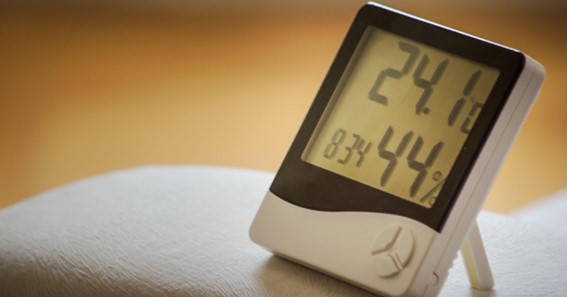Humidity refers to the presence of water in the atmosphere. Water vapor in the air has a significant impact on our lives and a variety of manufacturing operations. So, the next time someone asks, “What is a humidity sensor, and why does it matter?” You might respond that because humidity impacts physical, biological, and chemical processes, you can see how vital dampness is in every aspect of our existence. This amount is measured by air humidity sensors, transforming it into a readable form of data for external usage.
Bacteria, dust, and mold mites aren’t the only factors that get worse when there’s too much humidity in the air. As humidity rises, so do airborne compounds that have negative bodily impacts. When there is extreme humidity in the air, the concentration of the unpleasant compounds rises due to the chemicals’ reaction to water vapor. Even tiny doses of those chemicals can irritate the eyes, skin, throat, and respiratory symptoms.
How Humidity Sensors Operate
It would be best to understand how these sensors work to provide the best answer to the subject you looked for–what is a humidity sensor.
A polymer reacts with water vapor in the air, and two electrodes, one on either side of the polymer, make up modern capacitive humidity sensors. The polymer collects and releases water vapor as the relative humidity of the air changes, modifying the capacitance of the sensor. These changes are measured using two electrodes, then communicated to a device that interprets and relays the data. Over time, this type of sensor has proven to be highly reliable and predictable.
click here – Hatta Tour From Dubai
Applications Of Humidity Sensor
Printers, HVAC systems, fax machines, vehicles, weather stations, refrigerators, food processing, and other applications use capacitive relative humidity sensors. Because of their compact size and inexpensive cost, resistive sensors also get employed in domestic, commercial, and industrial applications. Drying machines, food dehydration processes, pharmaceutical facilities, and other applications use thermally conductive sensors. High humidity can affect blood flow; thus, controlling and detecting humidity in our homes and offices is critical.
The following are a few examples of humidity sensor applications.
- Industrial: It is necessary to use humidity sensors in industries such as chemical, refining, metal, and others that use furnaces because high humidity reduces the amount of oxygen in the air. Other sectors that could benefit from it include paper, textiles, and food manufacturing.
- Agriculture: Drip irrigation is a type of irrigation that demands exact moisture levels in the plants. The moisture content of the soil is also essential for the plant’s development. Indoor plants can benefit from humidity sensors.
- Electronics And Semiconductors: Humidity levels define a wide range of electronic devices. The humidity level is usually between 10% and 50%. Furthermore, semiconductor fabrication facilities must maintain extremely accurate humidity and temperature levels, as even minor fluctuations can significantly impact production.
- Medical: Sterilizers, incubators, and ventilators all require humidity regulation. The humidity sensor is also helpful in biological and pharmaceutical applications.
click here – Ways digital marketing students are becoming successful entrepreneurs
The Importance Of Temperature And Humidity Sensors
Temperature and humidity sensors are extensively used environmental sensors. Hygrometers are another expression for humidity sensors. These instruments determine the appropriate humidity level in the air at any specific location or point. Such devices aid in situations where air quality is a concern or when it is necessary to control the air quality for various reasons.
The amount of water vapor in the air is humidity. Individual comfort and industrial production processes are affected by the amount of water vapor present in the air. Moisture or humidity levels, for example, must be adequately monitored and regulated in the semiconductor industry to ensure suitable wafer fabrication. Humidity regulation is generally required for incubators, breathing apparatus, sterilizers, and biological products. In addition, the existence of water vapor may impact other chemicals and natural and physical processes.
Measuring humidity in the environment is essential since the higher the humidity, the warmer it may appear. In many sectors, measuring humidity is critical since it may impact the health and safety of employees and the cost of the product. Consequently, temperature and humidity sensors are frequently vital.
Humidity is also an essential part of weather forecasting because it indicates the chance of dew, fog, or precipitation. Greater relative humidity diminishes the efficiency of perspiration in cooling the body. It happens when sweat is unable to evaporate from the skin. Greater relative humidity decreases the efficiency of perspiration in cooling the body. As a result, locations with higher relative humidity may feel hotter during the summer.
When selecting temperature and humidity sensors, it is essential to consider specific criteria. These are some of the elements:
- Repeatability
- Accuracy
- Long-term Consistency
- Interchangeability
- Anti-condensation Resistance
- Contaminant Resistance: Both Physical And Chemical
- Packaging
- Size
- Cost-effectiveness
Summary
Humidity sensors produce an electrical output signal based on the moisture content of the air, gasses, bulk materials, or soil.
The demand for higher precision, repeatability, and long-term stability for humidity sensors is growing. Wireless humidity sensors are increasingly used in greenhouses, industrial applications, and even homes to monitor humidity levels.
Takeaway
Additional considerations for varied applications are required. In industrial applications, critical concerns are the system’s environment and the sensor’s resilience to chemicals and contaminants. For example, in healthcare applications that need precise conditions and repeatable measurements, the ability to maintain a clean atmosphere is often essential. Humidity sensors are critical for preventing the growth of bacteria and mold in HVAC and transportation systems. If you have any additional questions about humidity sensors, ask the professionals.






